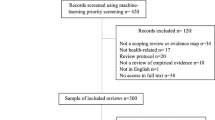Abstract
Data visualisation techniques are valuable tools for exploring, synthesising and communicating the results of research studies. Advanced data visualisation techniques, including dynamic and interactive visualisations, are just beginning to be used in health economics and outcome research (HEOR). In HEOR, there is the potential to use these techniques both to explore methodological challenges that are central to the design and interpretation of the findings of pharmacoeconomic and outcomes research studies, but also to communicate research findings to various stakeholders. In this manuscript, we discuss opportunities and methodological challenges for data visualisation specific to HEOR, describe external barriers that may impact the use of data visualisation methods, and discuss future applications of this technology in HEOR. While there are a number of obvious applications within the data-heavy field of HEOR, caution is required to ensure that visualisations, particularly advanced ones, accurately and fairly reflect the underlying data. However, researchers will benefit from adopting these increasingly sophisticated techniques to help ensure that decisionmakers and other stakeholders can understand, digest and communicate the data—which is critical for achieving the ultimate goal of improving patient outcomes.
Similar content being viewed by others
References
Healy K. Data visualization: A practical introduction. Woodstock: Princeton University Press; 2019.
Evergreen S. Effective data visualization: the right chart for the right data (Chapter 1). Los Angeles, CA: Sage; 2016.
Tufte E. The visual display of quantitative information (Chapter 1). 2nd ed. Cheshire, CT: Graphics Press; 2001. p. 13.
Munzer T. Visualization analysis & design. Boca Raton, FL: CRC; 2015. p. 116–44.
Evergreen S, Emery AK. Data visualization checklist. 2016 [cited 6-Feb-2019]; http://stephanieevergreen.com/wp-content/uploads/2016/10/DataVizChecklist_May2016.pdf.
Tufte E. The visual display of quantitative information (Chapter 5). 2nd ed. Cheshire, CT: Graphics Press; 2001. p. 136–7.
Munzer T. Visualization analysis & design. Oxford: CRC; 2015. pp. 1–20.
Marra C, Johnston K, Santschi V, Tsuyuki RT. Cost-effectiveness of pharmacist care for managing hypertension in Canada. Can Pharm J (Ott). 2017;150(3):184–97.
Broadstreet HEOR. Canadian Pharmacists Association Hypertension app. 2017. https://cpha.broadstreetheor.com/. Accessed 11 Apr 2019.
Pietila M. How next generation data visualization tools enable real-time efficiencies in clinical trials. Pharmaceutical Outsourcing; 2018.
Szabo SM, Hirji I, Johnston KM, Juarez-Garcia A, Connors JM. Treatment patterns and costs of care for patients with relapsed and refractory Hodgkin lymphoma treated with brentuximab vedotin in the United States: a retrospective cohort study. PLoS One. 2017;12(10):e0180261.
Broadstreet HEOR. Costs of RRHL in the US. 2017. https://demo.eviviz.com/hodgkin/. Accessed 11 Apr 2019.
Wyrwich KW, Norquist JM, Lenderking WR, Acaster S, Industry Advisory Committee of International Society for Quality of Life R. Methods for interpreting change over time in patient-reported outcome measures. Qual Life Res. 2013;22(3):475–83.
Badger E, Miller CC, Pearce A, Quealy K. Extensive data shows punishing reach of racism for black boys. New York Times 2018 [cited 20-Nov-2018]. https://www.nytimes.com/interactive/2018/03/19/upshot/race-class-white-and-black-men.html. Accessed 11 Apr 2019.
Embretson S, Reise S. Item response theory for psychologists. Mahwah, NJ: Psychology Press; 2000.
Fazio L, Rosner A, Drummond M. How Do U.S. Payers use economic models submitted by life sciences organizations? Value Outcomes Spotl. 2016:18–21.
Canadian Agency for Drugs and Technology in Health (CADTH). Procedure and Submission Guidelines for the CADTH Common Drug Review 2018.
Yau N. How I made that animated difference plot in R. 2018 Available from: https://flowingdata.com/2018/11/09/how-i-made-that-animated-difference-charts-in-r/. Accessed 11 Apr 2019.
Author information
Authors and Affiliations
Contributions
AJL and SMS were primarily responsible for drafting the manuscript, and all authors critically reviewed and edited the content. Participation in development of the visualisations was as follows: Pharmacist model: KMJ. Hodgkin lymphoma visualisation: KMJ, SMS. NMA visualisation: KMJ, SMS. Static Sankey plot: KMJ, SMS. Dynamic Sankey plot: AJL, SMS. Bivariate area chart: KMJ, AJL, SMS.
Corresponding author
Ethics declarations
Conflict of interest
SMS: none; KMJ: none; AJL: none.
Funding
None.
Rights and permissions
About this article
Cite this article
Szabo, S.M., Johnston, K.M. & Lloyd, A.J. Advanced Data Visualisation in Health Economics and Outcomes Research: Opportunities and Challenges. Appl Health Econ Health Policy 17, 433–441 (2019). https://doi.org/10.1007/s40258-019-00476-5
Published:
Issue Date:
DOI: https://doi.org/10.1007/s40258-019-00476-5









